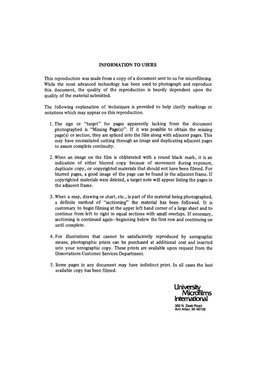| dc.contributor.author | Dhanasobhon, Churcksuwan, | en_US |
| dc.date.accessioned | 2013-08-16T12:28:47Z | |
| dc.date.available | 2013-08-16T12:28:47Z | |
| dc.date.issued | 1982 | en_US |
| dc.identifier.uri | https://hdl.handle.net/11244/5055 | |
| dc.description.abstract | Six hypotheses were accepted at the .05 level of significance, and only H(, O)5 was accepted at the .01 level of significance. | en_US |
| dc.description.abstract | The statistical treatments applied to the data obtained from the 324 questionnaires included frequencies, percentages, and means to describe the demographic data and the effectiveness scores of secondary school principals. Chi-square tests were employed to analyze the seven hypotheses. The .05 level of significance was the criterion used for accepting or rejecting the hypotheses. If a statistically significant value at the .05 level was obtained, the .01 level was computed for comparison purposes. | en_US |
| dc.description.abstract | The Demographic Data Questionnaire and the LEAD instruments as developed by Hersey and Blanchard at the Center for Leadership Studies at Ohio University were used to collect the data for this investigation. These instruments were administered to a random sample of principals and teachers in the secondary schools in Bangkok. The instruments were distributed to 34 secondary school principals and 340 secondary school teachers. Of the 374 subjects in the total sample, usable returns were received from 294 teachers (86.47 percent) and from 30 principals (88 percent). | en_US |
| dc.description.abstract | The principals were perceived more frequently by themselves and their teachers as utilizing leadership style III (high relationship and low task). There was agreement among the perceptions of principals and teachers about leader effectiveness of secondary school principals. Only one principal perceived himself or herself as ineffective, but none of the teachers considered his/her principal as ineffective. Sex, educational background, and the number of years served in the current profession had no effect on the perceptions of the leadership styles of secondary school principals. | en_US |
| dc.description.abstract | The purpose of this study was to determine the leadership styles of secondary school principals as perceived by principals and teachers in Bangkok, Thailand, and to determine whether sex, educational background, and years of experience affected these perceptions. Additional selected demographic data were collected in order to have pertinent information concerning the respondents. | en_US |
| dc.format.extent | ix, 144 leaves : | en_US |
| dc.subject | Education, Administration. | en_US |
| dc.title | Leadership styles of secondary school principals as perceived by selected principals and teachers in Bankok, Thailand. | en_US |
| dc.type | Thesis | en_US |
| dc.thesis.degree | Ph.D. | en_US |
| dc.thesis.degreeDiscipline | Jeannine Rainbolt College of Education | en_US |
| dc.note | Source: Dissertation Abstracts International, Volume: 43-11, Section: A, page: 3468. | en_US |
| ou.identifier | (UMI)AAI8302460 | en_US |
| ou.group | Jeannine Rainbolt College of Education | |
